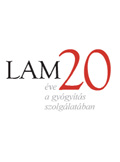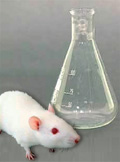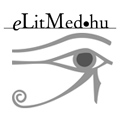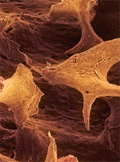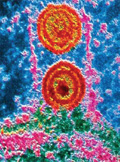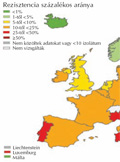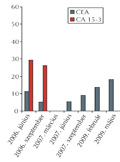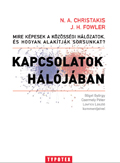The eLitMed.hu medical portal uses computer cookies for convenient operation. Detailed information can be found in the Cookie-policy.
Lege Artis Medicinae - 2011;21(05)
Content
[The modern disciplines of diagnosing and treating back pain]
[The author presents the recommendations of international guidelines in the modern diagnosis and treatment of low back pain. Regarding diagnosis, it is very important to differentiate between “specific” and “aspecific” or “nonspecific” low back pain. The term “specific low back pain” includes all diseases and pathologies with well-defined aetiology and pathological process, including bacterial spondylitis, rheumatic spondylarthropathies, primary or secondary tumours, malignancies, myelon- or cauda equine compression, paresis, metabolic base diseases, pathological or nonpathological fractures are suspected. The presence of so called “red flags” indicate“specific” low back pain. This type of low back pain requires quick and precise diagnosis and specific treatment. All other kinds of low back pain, even those with very painful radiculopathy, and without paresis, cauda- or myelon compression can be considered as aspecific, even if caused by a herniated disc, because there is no absolute indication of discectomy. In case of aspecific low back pain, there is no need of any diagnostic imaging methods, because they would not influence treatment. The main points of treatment are to keep the patient active, quick mobilisation with appropriate analgesia and antiinflammatory treatment following no more than 2-3 days of bed rest, and return to work as soon as possible, with easier work conditions if needed. The longer the patient is on sick leave, the higher the risk he or she will never return to work. If initial active treatment is not is effective enough, the patient's case should be reassessed in 3-6 weeks. If a herniated disc is suspected, the necessary imaging methods should be performed, and the patient should be operated if necessary. With this method, chronic, disabling low back pain can be avoided in many cases. The danger of developing chronic low back pain are indicated by the so called “yellow flags”: dissatisfaction with work, allowance claim, insufficient and even false ideas about the causes and consequences of low back pain, fear, anxiety, depression. These problems can be alleviated by the positive athmosphere of the workplace, appropriate patient education, activity, anxiolytic and antidepressant drugs, activity and regular exercise.]
[Development of anticoagulation in the past two decades]
[In the past two decades we have witnessed a gradually increasing significance of both prophylactic and therapeutic anticoagulation. The importance of thromboprophylaxis has become widely accepted in the course of surgical interventions and in various other fields of medicine, too. The introduction of low molecular weight heparins was a milestone in this respect. The need for long-term anticoagulation has become a common problem. The various recent aspects and topics of anticoagulation have been described in the current Hungarian medical literature, therefore, I focus on two general problems of medicine of our days from the aspects of our subject. The evaluation of information on the new, direct-acting inhibitors (anti-IIa and anti- Xa),and their high price present great difficulies, especially in the case of long-term anticoagulation therapy. Clinical data and experiences have been collected from patients who are greatly different from the majority of patients in the real world. The lack of antidote may also be a serious problem in case of these new drugs, as urgent neutralization might be necessary, for example in case of serious bleeding, accidents etc. Today, cost-effectiveness of medical interventions and drugs has become a major aspect, therefore, the high price of new anticoagulants might prevent their use in the clinical practice. Despite the optimistic expectations regarding new anticoagulants, at present we have to strive to treat our patients with the currently available, effective but affordable drugs, widening and improving their use.]
[The place of sulphonylurea compounds in the blood glucose lowering therapy of type 2 diabetes]
[The mechanism of blood glucose lowering action of sulphonylureas, their advantages and potencial risks are overviewd in the article. The author delineates the present place of the sulphonylurea group in the antihyperglycemic therapy of type 2 diabetes, listing possibilities of monotherapeutic as well as combined applications. It is emphasized that traditional insulin-secretagogue compounds have their place in the therapy of type 2 diabetes even beside of the new, incretin-type secretagogues.]
[A new fix combination therapy in effective cardiovascular prevention]
[A large amount of literature is available one modern antihypertensive therapy. The experiences of the past 10-20 years have changed clinical practice in many areas of medication and of prevention of complications. Therapy has been revolutionised not only by the new and newer agents but also by the introduction of combined therapy. In this paper, we discuss the use of a new fix-combination antihypertensive drug, with two components (telmisartan and amlodipine) about which excellent evidence is available. We highlight the advantages of this combination therapy in cardiovascular prevention, which is partly explained by better patient compliance due to its favourable side-effect profile.]
[Specialists’ mobility in surgery and gynaecology-obstetrics in Hungary]
[The new government inaugurated in 2006, started a most comprehensive professional and territorial restructuring of the hospital network in the recent decades. While performing it, the health administration took in account also the considerable re-allocation of the domestic medical workforce. The joint mobility program launched by the Ministry of Health and the Ministry of Social Affairs and Labour supported doctors and nurses changing their habitation provided they had lost their working place by reorganisations. The obvious failure of this program indicated very clearly the lack of mobility of involved physicians (only 24 physicians and 11 nurses applied to be supported). The present study based on data of registered specialists in December 2009 analyses the graduate training and professional mobility patterns of surgeons and gynaecologist-obstetricians born in Hungary and abroad as well. Among surgeons (N=1469) there is 13.5% and among gynaecologist-obstetricians (N=1377) 10.6% the proportion of those born abroad. Results obtained show a very strong adherence of domestic professionals to the regional community, however this adherence exists parallel with the crossnational migration of the same workforce both indicating the essential role of immigrant specialists while providing health care in this country.]
[The concept of adherence and its significance in osteoporosis]
[Today, in relation to the economical aspects of medical therapies, the patterns of patients’ drug taking have come into focus. One of the important indicators is adherence, which consists of four different concepts concerning faithfulness to therapy: acceptance, concordance, persistance and compliance. In chronic diesases, medical therapy without a certain degree of adherence is no more useful than no therapy at all. A number of international clinical studies show that in osteoporosis, the therapy can only lead to a decrease in the number of fracture in case of sufficient adherence.]
[Increasing importance of invasive fungal diseases]
[INTRODUCTION - Invasive mycoses are life-threatening fungal infections affecting patients with severe underlying conditions or impaired immune system. According to epidemiological studies, the incidence of invasive mycosis is increasing in several patient groups. CASE REPORT - In patients who require ICU care, the majority of invasive mycoses are caused by Candida species. A shift has been observed within the spectrum of pathogenic species. In patients undergoing chemotherapy for acute leukemia and in recipients of allogenic stem cell transplantation, however, an increased morbidity and mortality of invasive aspergillosis have been observed. The authors discuss current issues regarding the diagnosis and treatment of invasive fungal diseases on the basis of case reports. CONCLUSION - Invasive mycoses are lifethreatening infections affecting patients with severe underlying conditions. While the opportunities of state-of-the-art medicine are expanding, the incidence and significance of these infections increases. If detected and treated in time with appropriate antifungal agents, these infections can be efficiently treated.]
[Acute hepatitis caused by herpes simplex virus 1]
[INTRODUCTION - Herpes simplex virus is a rare and severe disease, which is often lethal, especially in children and those who underwent transplantation. Rapid diagnostic help determines therapy and facilitates recovery of the patient. CASE REPORT - The authors present a case of a 46-year-old patient with no underlying disease, in whom the diagnosis of hepatitis caused by herpes simplex-1 virus was suggested after histological evaluation of a blind liver biopsy specimen. The diagnosis was later confirmed by immunomorphological examination. The patient’s hepatitis resolved following acyclovir therapy, but he developed nosocomial pneumonia, sepsis caused by Candida albicans and anuria. The patient recovered due the joint efforts of an infectologist, a pathologist, an intensive care specialist and a nephrologist. CONCLUSION - During examination of the patient, immune suppression was not indicated either by HIV-serology or bone marrow biopsy. thus the findings were presumably explained by a generalised infection in an immunocompetent host. In the case described, histological examination of the liver biopsy was a life-saving procedure, because it allowed timely and efficient treatment.]
1.
Clinical Neuroscience
[Headache registry in Szeged: Experiences regarding to migraine patients]2.
Clinical Neuroscience
[The new target population of stroke awareness campaign: Kindergarten students ]3.
Clinical Neuroscience
Is there any difference in mortality rates of atrial fibrillation detected before or after ischemic stroke?4.
Clinical Neuroscience
Factors influencing the level of stigma in Parkinson’s disease in western Turkey5.
Clinical Neuroscience
[The effects of demographic and clinical factors on the severity of poststroke aphasia]1.
2.
Clinical Oncology
[Pancreatic cancer: ESMO Clinical Practice Guideline for diagnosis, treatment and follow-up]3.
Clinical Oncology
[Pharmacovigilance landscape – Lessons from the past and opportunities for future]4.
5.





